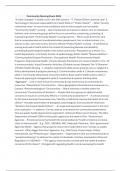Community Nursing Exam 2024
*3 major changes* in health care in the 20th century - *1. Patient/Client centered care* 2.
Technology 3. Personal responsibility for health What is *"Public Health"* - -What *society
collectively does* to ensure that conditions exist in which people can be healthy
*Community Health* nursing - -Use of systematic processes to deliver care to individuals,
families, and community groups with a focus on promotion, preserving, protecting, &
maintaining health *Community-Based* nursing practice - -Minor acute & chronic care
that is comprehensive and coordinated where people work, live, or attend school -(i.e.,
school nurses, stat care nurses, doctor's offices) *Public Health* nursing - -A synthesis or
nursing and public health within the context of preventing disease and disability,
promoting & protecting the health of the entire community -Population as a whole -(i.e.,
health department, community boards, & epidemiology) Public Health *Responsibilities* -
-Communicable Disease Prevention -Occupational Health -Environmental Health
Programs -Reproductive Health -Chronic Disease Prevention (#1 cause of death in U.S., #2
is communicable) -Injury Prevention Activities (Children across lifespan) The *8 Domains*
of Public Health Nursing - 1. Analytic assessment skills (never group by race or religion!) 2.
Policy development & program planning 3. Communication skills 4. Cultural competency
skills 5. Community dimensions of practice skills 6. Basic public health science skills 7.
Financial planning & management skills 8. Leadership & systems thinking skills
*Aggregate* - -Live or work in/out of community & may travel in/out of community for
resources *Geopolitical* Communities - -Share geographical boundaries & resources (i.e.,
Canton) *Phenomenological* Communities - -Share interests or beliefs within the
community *Communities of Solution* - -People that form groups to address health
concerns or issues in community What's a *community assessment*? - -A critical process
for the future because the process may *identify a method to improve the health of at-risk
clients* -Includes examination of biological, psychological, & sociocultural influences
*Gordon's Functional Health Pattern* - -An organized approach to assessment in the form
of an evaluation -11 patterns -Can be used as a framework for community assessments
How are public health departments organized? - National>State>Local>County -The Ohio
Department of Health (ODH) is the public agency for the state of Ohio *Government*
Agencies - -Provide services that benefit the social welfare & *health of citizens at a local,
state, & national level* -E.g., CDC, USDHHS, WIC, Medicaid, Medicare, *Non-government*
Agencies (NGO) - -Agency that acquires resources to help others from *private vs. public
sources* -Often bigger than Gov't Agencies -E.g., Red Cross, Project Hope, Oxfam
International, J&J *Philanthropic* Organization - -Organizations that use endowed funds or
*private fundraising* to address the needs of individuals, families, & population Role and
Regulation of *USDHHS* - -*The agency most heavily involved with the health & welfare
concerns of US citizens* -Charged with regulating health care & overseeing the health
, status of U.S. citizens or *Refugees/Asylees* -Directed by Secretary of Health -Collaborate
with the State & Local Health Departments -All other Gov't agencies fall under USDHHS
(e.g., CDC, State Health Departments, etc.) What are *Public Health Entities* and how are
they related to the *Federal Gov't*? - -The Federal Gov't plays and important role in the
regulation of *Public Health Entities*: 1) Food 2) Medications (FDA) 3) Devices 4)
Occupational Health 5) Environment -Federal Gov't *creates policy* and allocates funds -
Federal Gov't *provides services* that benefit the social welfare of citizens (safeguards the
public) What must every state *report yearly*? - 1) Health status and it's determinants (i.e.,
Morbidity & Mortality) 2) Utilization of health care resources (i.e., track public usage of
facilities and resources) *3) Health expenditures* (i.e., where is the Federal Gov't's money
going?) 4) Vulnerable populations and health care (i.e., What individuals are at high risk of
morbidity and mortality?-Low socioeconomic status) *Multilateral* Agencies - -Funding
from multiple Gov'ts & funds going anywhere based on need -E.g., WHO (goal? Make the
world healthy), World Bank (offers loans based health *Bilateral* Agencies - -Single
country giving to another (rich to poor) -Often based on good/cooperative relations E.g.,
USAID (The U.S. Agency for International Development) WHO Definition of *Health* - -A
state of complete physical, mental, & social well-being, not merely the absence of disease
or infirmity *#1 Risk Factor* that affects disease burden in high income countries? - -
Smoking #1 -HTN #2 -Hyperlipidemia #3 -Obesity #4 *WHO Health Indicators* in order... -
1) Morbidity & Mortality (What's trending?) 2) Risk Factors (What is causing it?) 3) Health
Service Coverage (# of services available in area) 4) Health System Resources (What do we
have available) Ten Highlights of the *WHO World Health Statistics Report* for 2008 - 1)
Maternal mortality is declining too slowly 2) The gap in coverage in the four key intervention
areas of family planning, maternal and neonatal care, immunization, & Tx of sick children
remains wide 3) The number of ppl living with HIV continues to rise but is lower than
previously expected 4) Use of insecticide-treated nets to prevent malaria has increased,
but the poor do not benefit as much from malaria interventions 5) Tobacco use is a risk
factor for six of the eight leading causes of death 6) Less than a quarter of women aged 50-
69 years had a breast cancer screening 7) Excess mortality in Europe is due to
noncommunicable diseases and injuries 8) Meningococcal meningitis epidemics in Africa
call for a system of early detection & Tx 9) Noncommunicable conditions will cause over
three quarters of all deaths in 2030 10) 150 million people suffer catastrophic healthcare
costs each year *UN Millennium Development Goals* (8 goals) - -Believe that all people
have a right to health -Developed by the United Nations *Goal 1*: Eradicate extreme
poverty & hunger *Goal 2*: Achieve universal primary education *Goal 3*: Promote gender
equality & empower women *Goal 4*: Reduce child mortality *Goal 5:* Improve maternal
health *Goal 6*: Combat HIV/AIDS, malaria & other diseases *Goal 7*: Ensure
environmental sustainability *Goal 8*: Develop a global partnership for development




